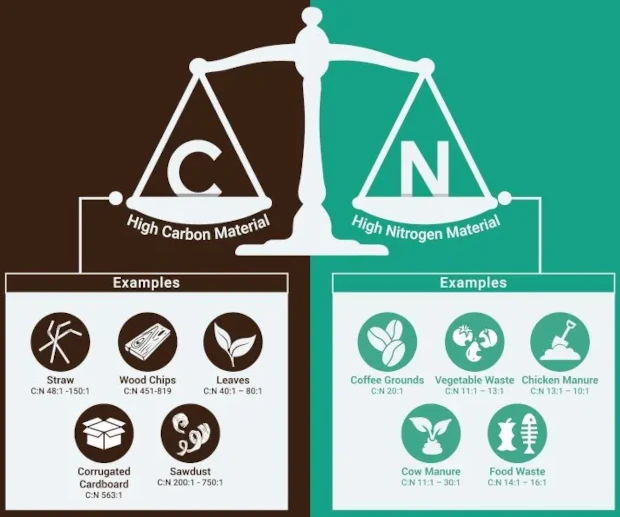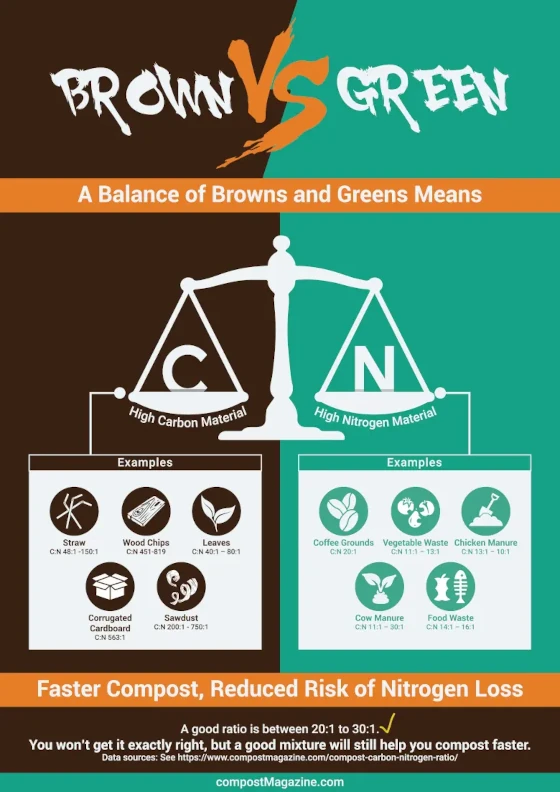Composting: explaining the carbon-nitrogen ratio

If you read much about composting, you’ll soon come across the terms carbon:nitrogen ratio (often shortened to C:N ratio). Everything you put in your compost has a different C:N ratio. Materials such as grass and manure, known as ‘greens’, have a higher level of nitrogen, and ‘brown’ materials, such as paper, have a higher level of carbon.
In this post we’re going to take a deep dive, looking at both why the ratio is important – AND why most gardeners shouldn’t get their calculator out every time they add a potato peeling to their compost!
Why is the C:N ratio important?
The microorganisms in a compost heap need four primary ingredients to get going. The most important for a gardener, and the focus of this article, are Carbon and Nitrogen. (The other two are Phosphorus and Potassium.)
The bacteria themselves consist of carbon and nitrogen, with a ratio of 8:1 (8 units of carbon to every 1 unit of nitrogen). To grow and multiply, they need carbon to maintain themselves and for energy, and nitrogen to grow proteins.
If the C:N ratio and other conditions are right, mesophilic microorganisms, which thrive in moderate temperatures, starting breaking down the organic material in the compost, producing heat in the process. These microorganisms do best in temperatures of around 20 to 45 degrees centigrade.
Mesophilic microorganisms are then replaced by thermophilic microorganisms, which thrive in high temperatures. The heat kills pathogens and weed seeds, and the materials rapidly breakdown, speeding up this phase of the composting process. (See Compost Science for a more in-depth explanation.)
Add too much carbon and the compost process will slow down. If you have too much nitrogen, nitrogen will be lost in the form of ammonia (which will also lead to an unpleasant smell).
Carbon rich materials can provide other functions for the compost heap. Wood chips can help build structure, while other “browns” like paper and cardboard can help absorb excess liquid released from the breakdown process.
Getting a good carbon:nitrogen ratio is not just about efficient composting, it could also help the environment. According to Practical Compost Engineering (Haug, 1993), when you have the right mixture, Ammonia released from high nitrogen sources can be captured for synthesis by microbes in nitrogen-poor material instead of being released into the atmosphere.

What is the best Carbon:Nitrogen ratio for composting?
One key experiment was done by McGaughey and Gotass in 1953. The researchers tested Carbon:Nitrogen ratios varying from 201 to 78:1. They found that the optimum range for speed was between 30:1 to 35:1. Below this range excess nitrogen was lost, while above this range the composting speed slowed down. However, even when a Carbon:Nitrogen ratio of 78:1 was used compost was still produced in 21 days.
Another study by Ogunwande found that a Carbon:Nitrogen ratio of 25:1 resulted in the minimum loss of nitrogen in the process. However, all ratios tested (from 20:1 to 30:1) resulted in compost maturing at 80 days.
Campus Extension suggests that you should get good results anywhere between 20:1 and 40:1, and sometimes as high as 50:1. Meanwhile, The Practical Handbook of Compost Engineering argues that keeping a C:N ratio above 15:1 will help ensure nitrogen is not lost and ammonia is not released into the climate.
In short, research suggests that the ideal ratio is around 25:1 to 35:1, but you can produce successful compost with a wider range of carbon:nitrogen ratios.
Compost Material Breakdown Rates
The C:N ratio is not the only thing that affects the composting process. Another factor (although not the only one) is the speed at which high carbon materials break down.
Woody materials contain a high concentration of lignin, a substance which breaks down more slowly, while fruit waste, which contains higher levels of cellulose, breaks down more quickly. A compost heap with a predominantly wooden carbon source will eventually lose the ideal carbon:nitrogen ratio, slowing the process down and causing it to become smelly.
At the same time, woody materials can provide structure to the compost and help create air-pockets to provide oxygen for the microbes. In an ideal world, it’s probably best to use both a mixture of both woody and non-woody browns.

How much do you need to worry about it?
Personally, I think the average garden composter shouldn’t spend too much time worrying about the exact carbon-nitrogen ratio of their compost.
Unless you’re going to get a calculator and a weighing machine out every time you add material to your compost, you’re not going to get it perfect. Every material has a different carbon:nitrogen ratio, and even some of the academic sources disagree on exactly what those are.
Even if you can work out the exact carbon:nitrogen ratio, you still need to take into account the volume of material, how much air and moisture it contains, and the speed at which it breaks down. (If you do want to calculate the amounts needed, Cornell University provide some handy spreadsheets to help.)
Perhaps that why many experienced composters just don’t worry too much about the ratio. For example, Charles Dowding of No Dig Gardening, who produces large amounts of compost for his market garden, aims for a roughly 50:50 mixture of greens and browns and gets excellent results.
Meanwhile, ‘Red Gardens’ utilises ‘No Rules’ composting.
In a community composting project, participants were allowed to bring any compost material they wanted, as long as it had been recently alive. A huge volume was generated, and the compost was turned regularly. But apart from separating out large portions of brush until it had been rotted down, no thought was given into the Carbon:Nitrogen ratio.
The results? Great!
High Carbon and High Nitrogen Compost Materials: Examples
While I may be sceptical of the value for the amateur composter of trying to calculate exact C:N ratios, it’s handy to have a rough idea of C:N ratios.
For starters, while it is difficult for the average amateur gardener to get the C:N exactly right, you do need to get it roughly right. What’s more, many problems can be solved by adding either high carbon or high nitrogen material. For example, if a compost is not warming up, adding high nitrogen material can quickly get it going. If a compost heap is starting to smell, add some high carbon material.
The examples below give C:N ratios – note the variation is often due to differences in sources. You can see a larger number of examples given in Appendix A of the On-Farm Composting Book.
Do note that not all Greens are green. In composting green refers to a source which is high nitrogen, not compost. For example, manure is brown, but is considered a green because of its nitrogen content.

Greens and Browns: Examples with carbon:nitrogen ratios
Greens
- Coffee Grounds: C:N 20:1
- Vegetable Waste: C:N 11:1 – 13:1
- Chicken Manure: C:N 13:1 – 10:1
- Cow Manure: C:N 11:1 – 30:1
- Horse Manure: C:N 22:1 – 50:1
- Sheep Manure: C:N 13:1 – 20:1
- Pig Manure: C:N 9:1 – 19:1
- Food Waste: C:N 14:1 – 16:1
- Grass clippings: C:N 9:1 -25:1
Browns
- Straw: C:N 48:1 -150:1
- Bark (hardwood): C:N 116:1 – 436:1
- Bark (softwood): C:N 131:1 -1,285:1
- Corrugated cardboard: C:N 563:1
- Sawdust: C:N 200:1 – 750:1
- Wood chips (hardwood): C:N 451-819
- Leaves: C:N 40:1 – 80:1
- Seaweed: C:N 5:1 – 27:1
This article first appeared in Compost Magazine
The views expressed in our blog are those of the author and not necessarily lowimpact.org's




 A guide to composting: the fundamentals
A guide to composting: the fundamentals
 A guide to composting: methods for composting outdoors
A guide to composting: methods for composting outdoors
 A guide to composting: methods for composting indoors
A guide to composting: methods for composting indoors
 Bokashi composting: A beginners guide to slimming down your black bin waste
Bokashi composting: A beginners guide to slimming down your black bin waste
 Composting
Composting
 Soil management
Soil management


